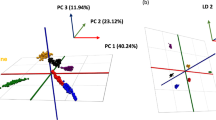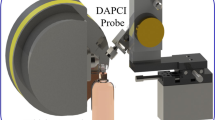Abstract
In an effort to characterize differently aged bourbons and to determine whether bourbons could be “fingerprinted” by their chemical compositions, we used Fourier transform ion cyclotron resonance mass spectrometry (FT-ICR MS) and liquid chromatography coupled with tandem mass spectrometry (LC-MS/MS) to characterize 2 distinct sets of bourbon samples. The first set of bourbons were prepared using the same mash bill but were aged differently (unaged (0 years), 2 years, 4 years, and 6 years) in oak barrels. The results showed an increase in the number of chemical compounds present as the bourbon ages. Most of the large changes in chemical composition occur in the first 2 years of aging. We also analyzed single barrel bourbons, which were produced identically but maturated in different, adjacent barrels, and the results suggested that significant differences exist among these samples. These results suggest that “fingerprinting” of different bourbons for authentication purposes may be complicated and that careful analyses, coupled with more comprehensive identification of chemical compounds in bourbons, are needed.





Similar content being viewed by others
References
Black C, Chevallier OP, Elliott CT (2016) The current and potential applications of ambient mass spectrometry in detecting food fraud. TrAC Trends Anal Chem 82:268–278
Bukovsky-Reyes SE, Lowe LE, Brandon WM, Owens JE (2018) Measurement of antioxidants in distilled spirits by a silver nanoparticle assay. J Inst Brew 124:291–299
Chambers J, Cleveland W, Kleiner B, Tukey P (1983) Graphical methods for data analysis. Wadsworth Int'l. Group, Belmont
Collins TS, Zweigenbaum J, Ebeler SE (2014) Profiling of nonvolatiles in whiskeys using ultra high pressure liquid chromatography quadrupole time-of-flight mass spectrometry (UHPLC–QTOF MS). Food Chem 163:186–196
Crozier A, Jaganath IB, Clifford MN (2009) Dietary phenolics: chemistry, bioavailability and effects on health. Nat Prod Rep 26:1001–1043
Ghaste M, Mistrik R, Shulaev V (2016) Applications of Fourier transform ion cyclotron resonance (FT-ICR) and orbitrap based high resolution mass spectrometry in metabolomics and lipidomics. Int J Mol Sci 17:816
Glabasnia A, Hofmann T (2006) Sensory-directed identification of taste-active ellagitannins in American (Quercus alba L.) and European oak wood (Quercus robur L.) and quantitative analysis in bourbon whiskey and oak-matured red wines. J Agric Food Chem 54:3380–3390
Gollihue J, Richmond M, Wheatley H, Pook VG, Nair M, Kagan IA, DeBolt S (2018) Liberation of recalcitrant cell wall sugars from oak barrels into bourbon whiskey during aging. Sci Rep 8:15899
Heinz HA, Elkins JT (2019) Mash Bill using gas chromatography/mass spectrometry. Journal of brewing and distilling 8(1):1–6
Kataoka S (2005) Functional effects of Japanese style fermented soy sauce (shoyu) and its components. J Biosci Bioeng 100:227–234
Kew W, Goodall I, Clarke D, Uhrín D (2017) Chemical diversity and complexity of scotch whisky as revealed by high-resolution mass spectrometry. J Am Soc Mass Spectrom 28:200–213
Minnick F (2016) Bourbon: the rise, fall, and rebirth of an American whiskey. Voyageur Press, Minneapolis
Minnick F (2019) Bourbon curious: a tasting guide for the savvy drinker with tasting notes for dozens of new bourbons. Harvard Common Press, Minneapolis
Mitenbuler R (2016) Bourbon empire: the past and future of America’s whiskey, Penguin
Murray J (2017) Jim Murray’s whisky bible 2018. Wellingborough, Dram Good Books Ltd, p 384
Ochiai N, Sasamoto K, MacNamara K (2012) Characterization of sulfur compounds in whisky by full evaporation dynamic headspace and selectable one-dimensional/two-dimensional retention time locked gas chromatography–mass spectrometry with simultaneous element-specific detection. J Chromatogr A 1270:296–304
Pryde J, Conner J, Jack F, Lancaster M, Meek L, Owen C, Paterson R, Steele G, Strang F, Woods J (2011) Sensory and chemical analysis of ‘Shackleton’s’ Mackinlay scotch whisky. J Inst Brew 117:156–165
Rogers A (2014) Proof: the science of booze. Mariner Books, Boston, p 288
Roullier-Gall C, Witting M, Gougeon RD, Schmitt-Kopplin P (2014) High precision mass measurements for wine metabolomics. Front Chem 2:102
Roullier-Gall C, Witting M, Tziotis D, Ruf A, Gougeon R, Schmitt-Kopplin P (2015) Integrating analytical resolutions in non-targeted wine metabolomics. Tetrahedron. 71:2983–2990
Roullier-Gall C, Signoret J, Hemmler D, Witting MA, Kanawati B, Schäfer B, Gougeon RD, Schmitt-Kopplin P (2018) Usage of FT-ICR-MS Metabolomics for characterizing the chemical signatures of barrel-aged whisky. Front Chem 6:29
Russell I, Bamforth C, Stewart G (2014) Whisky: technology, production and marketing, 2nd edn. Elsevier, Academic Press, p 444
Sha S, Chen S, Qian M, Wang C, Xu Y (2016) Characterization of the typical potent odorants in Chinese roasted sesame-like flavor type liquor by headspace solid phase microextraction–aroma extract dilution analysis, with special emphasis on sulfur-containing odorants. J Agric Food Chem 65:123–131
Spedding G (2017) 80 Years of Rapid Maturation Studies—Why Are We There Yet? Part 1 of 3 Part 1: Key Analytics and Solvent Chemistry. Distiller
Suomalainen H, Keränen A (1968) The fatty acid composition of baker’s and brewer’s yeast. Chem Phys Lipids 2:296–315
Teodoro JAR, Pereira HV, Sena MM, Piccin E, Zacca JJ, Augusti R (2017) Paper spray mass spectrometry and chemometric tools for a fast and reliable identification of counterfeit blended Scottish whiskies. Food Chem 237:1058–1064
Tukey JW (1977) Box-and-whisker plots. Exploratory data analysis 2:131–160
Veach MR (2013) Kentucky bourbon whiskey: an American heritage. University Press of Kentucky
Wang X, Liu Y, Su Y, Yang J, Bian K, Wang Z, He L-M (2014) High-throughput screening and confirmation of 22 banned veterinary drugs in feedstuffs using LC-MS/MS and high-resolution orbitrap mass spectrometry. J Agric Food Chem 62:516–527
Wiśniewska P, Dymerski T, Wardencki W, Namieśnik J (2015) Chemical composition analysis and authentication of whisky. J Sci Food Agric 95:2159–2166
Yoshioka S, Terashita T, Yoshizumi H, Shirasaka N (2011) Inhibitory effects of whisky polyphenols on melanogenesis in mouse B16 melanoma cells. Biosci Biotechnol Biochem 75(12):2278–2282. https://doi.org/10.1271/bbb.100514
Acknowledgments
The 15-T Bruker SolariXR FT-ICR instrument was supported by NIH Award Number Grant S10 OD018507.
Funding
This research was supported by a Miami University Committee on Faculty Research grant (to MWC).
Author information
Authors and Affiliations
Corresponding author
Ethics declarations
Conflict of Interest
Kundi Yang declares that he has no conflict of interest. Arpad Somogyi declares that he has no conflict of interest. Caitlyn Thomas declares that she has no conflict of interest. Huan Zhang declares that he has no conflict of interest. Zishuo Cheng declares that he has no conflict of interest. Shenyuan Xu declares that he has no conflict of interest. Callie Miller declares that she has no conflict of interest. Devin Spivey declares that he has no conflict of interest. Colin Blake declares that he has no conflict of interest. Clay Smith declares that he has no conflict of interest. David Dafoe declares that he has no conflict of interest. Neil D. Danielson declares that he has no conflict of interest. Michael W. Crowder declares that he has no conflict of interest.
Ethical Approval
This article does not contain any studies with human participants or animals performed by any of the authors.
Informed Consent
Informed consent was obtained from all individual participants included in this study.
Additional information
Publisher’s Note
Springer Nature remains neutral with regard to jurisdictional claims in published maps and institutional affiliations.
Electronic Supplementary Material
ESM 1
(DOCX 15371 kb).
Rights and permissions
About this article
Cite this article
Yang, K., Somogyi, A., Thomas, C. et al. Analysis of Barrel-Aged Kentucky Bourbon Whiskey by Ultrahigh Resolution Mass Spectrometry. Food Anal. Methods 13, 2301–2311 (2020). https://doi.org/10.1007/s12161-020-01850-z
Received:
Accepted:
Published:
Issue Date:
DOI: https://doi.org/10.1007/s12161-020-01850-z




